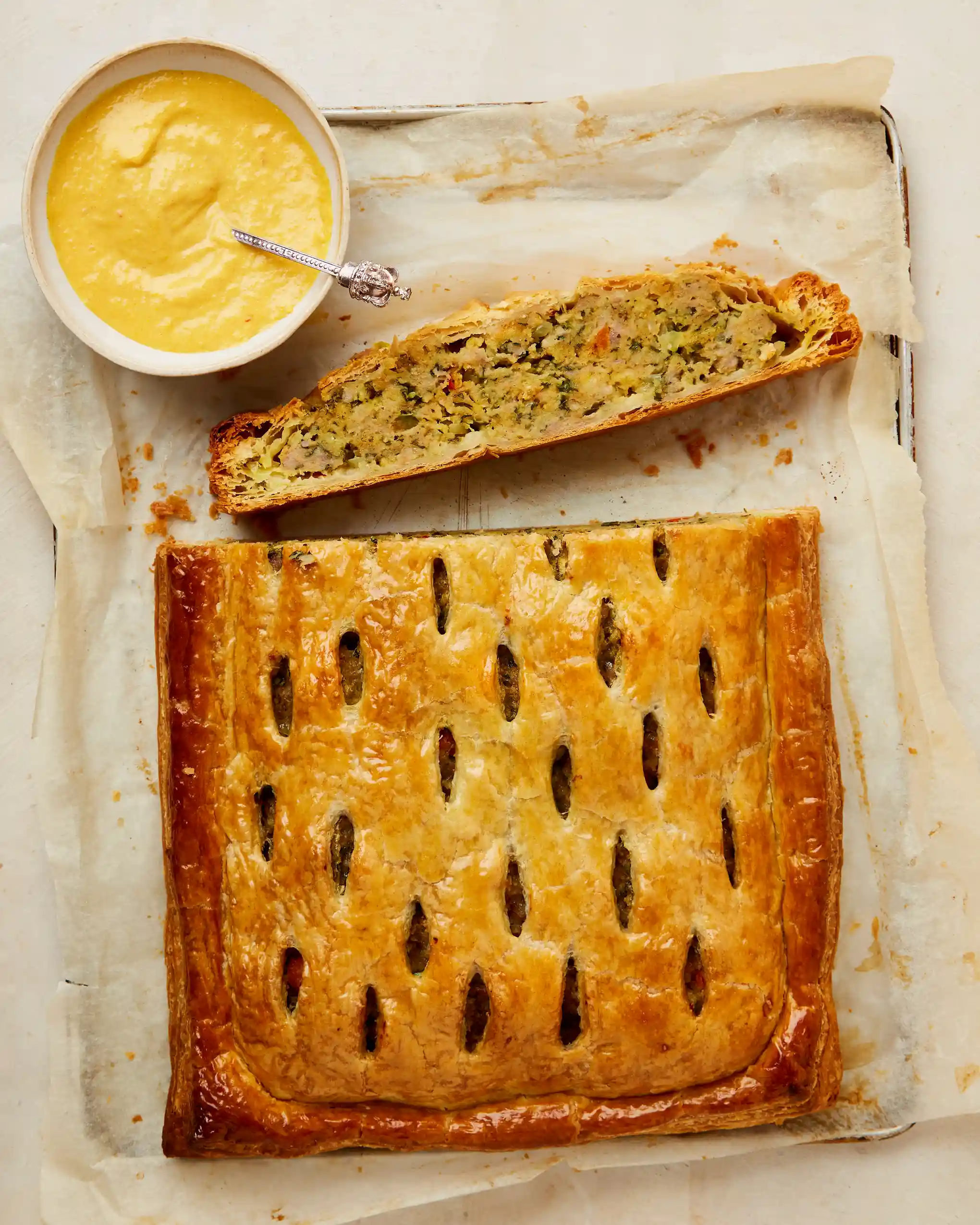Piccalilli
- rosemary
- Nov 11, 2023
- 7 min read
"Piccalilli is the most strange and wonderful of British condiments. Its mere neon-yellow presence evokes a world of tea cakes, tennis whites and summers spent pickling allotment vegetables to the sound of the cricket on the radio." Meera Sodha

I don't think I ever recall my mother making piccalilli. Indeed I don't actually remember it being a staple in our household. Not even an occasional visitor. So yesterday, with an overload of cauliflower in my fridge I thought I would have a go. No - the day before because you have to chop up your veggies, mix with salt and leave overnight before you begin.

I used the recipe from River Cottage's preserves expert Pam Corbin - Pam's Piccalilli - but with a slightly different mix of vegetables. Not that she was prescriptive I have to say. Cauliflower, beans and onion seem to me, having now perused numerous recipes, to be the constants, but there also seems to be a need for around five or six different vegetables. So I added red capsicum, carrot and celery. I had thought to use some cucumber I knew was languishing in the fridge, but alas it had languished too long and had gone mushy so was into the compost.

The spices also seem to vary a bit from recipe writer to recipe writer but turmeric is always there - to give it it's trademark bright yellow colour - also mustard, both seeds and powder and sometimes oil - cumin and coriander. Sometimes there is chilli, Ottolenghi has a bit of saffron, Jamie - Jamie's Piccalilli - some oregano, bay and curry leaves. It seems to be a fairly individual thing and of course everyone thinks their version is best.
Because of that turmeric you would immediately think, that this is yet another of those Anglo-Indian things that developed during the days of the Raj, and general opinion seems to be that this is true, but exactly how is much more of a mystery.
"Although piccalilli is one of Britain's favorite pickled dishes, surprisingly, its origins remain something of a mystery." Elaine Lemm/The Spruce Eats

All those other Anglo-Indian dishes have some kind of story attached but this one doesn't. There are two, almost origin stories, which do at least testify to its age, and also to what may have inspired it. For it is indeed very old - the first recipe is said to date back to Lady Ann Blencowe's Receipt Book of 1694, where she presents "To Pickle Lila, an Indian Pickle" crediting it to Lord Kilmory, although others prefer to ascribe the first recipes to either Hannah Glasse in 1758 ("to make Paco-Lilla, or India Pickle") or Elizabeth Raffald's The Experienced English Housekeeper of 1769 ("To make Indian pickle, or Piccalillo"). I guess the one thing you can get from these is that 'pica' and 'lila' or variations thereof seem to have clung to it and also that it is indeed, very old - from the early days of the East India Company.
"it is also a reassuring reminder of the love affair between Britain and India (from where the recipe was inspired) that is still played out in our kitchens more than 400 years after it first started." Meera Sodha

In my 'researches' I did not find a single explanation of the etymology of the word that was definite. The most likely sounding one that I found was from Oxford Languages who said: "probably from a blend of pickle and chilli" , which does indeed make sense, even though there is not always any chilli in it.
That reference to Indian pickle though is pretty constant, and Madhur Jaffrey in her Ultimate Curry Bible, proposes that it is derived from this Sweet and sour mixed vegetable pickle, Punjabi style. So I'm guessing that either some East India Company aristocrat brought an Indian cook back to England, who made this, or the British in India became enamoured of it, but had their cooks anglicise it a bit - mostly with English mustard which always features in the recipes that I found.

Suffice to say that by the late eighteenth century it was being produced commercially with the spelling that we all know these days. Well the spelling is tricky - all those double letters - which ones and where? It took me a while to get it. Because of that, the history, the people, the sociology of it all it would be a wonderful topic for that food-based curriculum I occasionally talk about.
"pickles burst with flavours that tell the story of our history as conquerors and the conquered, our restless imperial past in a jar." Hugh Fearnley-Whittingstall
The English do indeed love it - there are countless commercial versions in the supermarkets which all have their own home-brand version. You can get it here as well of course, from the bottom level home-brand, to the artisan versions in snooty food shops. However heed Delia's warning: "I've never found a good bought version except in small delis and farm shops." And it's not just her either - I found a few who said the same thing like Phil of Phil's Home Kitchen:
"All too often with commercial piccalilli, all you can taste is harsh vinegar with little more than a hint of mustard. If the vegetables themselves once had the opportunity to shine, they were murdered by being over-cooked, drenched in flavourless acid and squeezed into the jar with so many other varieties of vegetables that it all becomes something of an unpalatable vinegary mess!" Phil's Home Kitchen
Yes I know, recipe writers always think the home-made version is better, but they don't generally spell out why they are not good or are quite as definite. And, honestly it's very simple - you just have to slightly plan by starting the day before you make it.
As I said earlier, I made Pam Corbin's version, although if I actually like it, I shall try Jamie's next time. I didn't this time because it had a longer list of ingredients. Silly of me I know, but Pam Corbin is very reliable when it comes to preserves. Although! When I had put my brilliant yellow mixture in the jars, I found that I did not have enough sauce to cover the vegetables entirely. Nevertheless I put the lids on and left them overnight. But it worried me and so I made a bit more of the sauce and poured it over the next day. Another half quantity in fact, which was just right. David made some labels and here it is.

I actually had to adapt a bit on the vinegar as well. I did not have enough cider vinegar, so started making the quantity up with malt vinegar before thinking that maybe it should be wine vinegar, so I swapped. I just hope I was not too late, because I later came across this piece of advice:
"not malt vinegar here at all: it is far too strong and masks the flavours of the vegetables and the spices." Phil's Home Kitchen
Ouch. I think I only put in a bit of malt vinegar - I did it because I thought it was British. Too British in fact it seems. Only time will tell - you have to leave it for four weeks before trying.

So what do you do with it?
Well actually not a lot other than just eating it as an accompaniment to the usual things, such as pork pies and cheese as shown here. In Britain it's a common component of the Ploughman's lunch. Sandwiches and burgers - that sort of thing or as a side on a cheese platter. Well I suppose it's a kind of chutney although one fan said:
"Piccalilli is the sweet-sharp contrast that chutney has always tried to be, but better." Cooking Clue
So if you do nothing else, just put it in a pretty dish and serve it next time on your antipasti platter, with a British theme - less olives, more pickled walnuts, pickled onions and piccalilli. Just kidding. I'm sure you can mix it with Middle-Eastern and Mediterranean mezze things.
I did find a few suggestions though. Generally speaking a few people mixed it into salads, like potato salads and lentil salads. And then there were a few tart suggestions, which just goes to prove that you can put anything in a tart really: Cheese and piccalilli tart from the current baking queen Nadiya Hussain; Smoked salmon and piccalilli mini tarts/Female First and
Caerphilly, leek and piccalilli tarts from the British company that makes cheese and accompanying things - Paxton & Whitfield. Caerphilly is hard to come by here - you might find Wensleydale which is similar. It's crumbly and tart. Ottolenghi had an interesting Jubilee sausage pie with piccalilli yoghurt in which the piccalilli appeared twice - in the sausage filling and also in the accompanying yoghurt.

And really the only other thing of interest that I found was Piccalilli spiced rice from Meera Sodha. Maybe there are not more suggestions because it's so delicious on its own? I shall have to try it when the month of storage is up. It had better be good - I have five jars of it!
Well the British are sometimes a bit weird.
"Piccalilli is a curious, luminous, distinctly delicious pickle relish" Cooking Clue

POSTSCRIPT
This is my last leftover sausage dish. We had it last night, and yes I know it was two weeks after those sausages were cooked. I checked the sausages out very carefully - no green or mouldy looking bits, and they smelt just like cooked sausages should. The proof is in the eating as both David and I are perfectly fine. Which just goes to prove I think that sight and smell are much better indicators of when things have gone off than other more prescriptive statements.
So what is leftovers dish no. 5? Yes 5. Well it's a kind of choucroute. I fried the sausages cut into chunks with some strips of ham. When they were looking brownish I added sliced onions and garlic and fried a little longer. Then I added about half a jar of my home-made sauerkraut, which I had rinsed first, stirred it around and then added some, chopped parsley, lemon juice and white wine. Last of all were some potatoes. Lid on, and cooked on the stove top for around three-quarters of an hour. Done and delicious. Oh - more parsley on top to make it look a bit more appetising. The photograph is not that great - I am not an award winning or even just professional, food photographer.
Unlike piccalilli it seems, there is a lot you can do with leftover sausages.







Comments